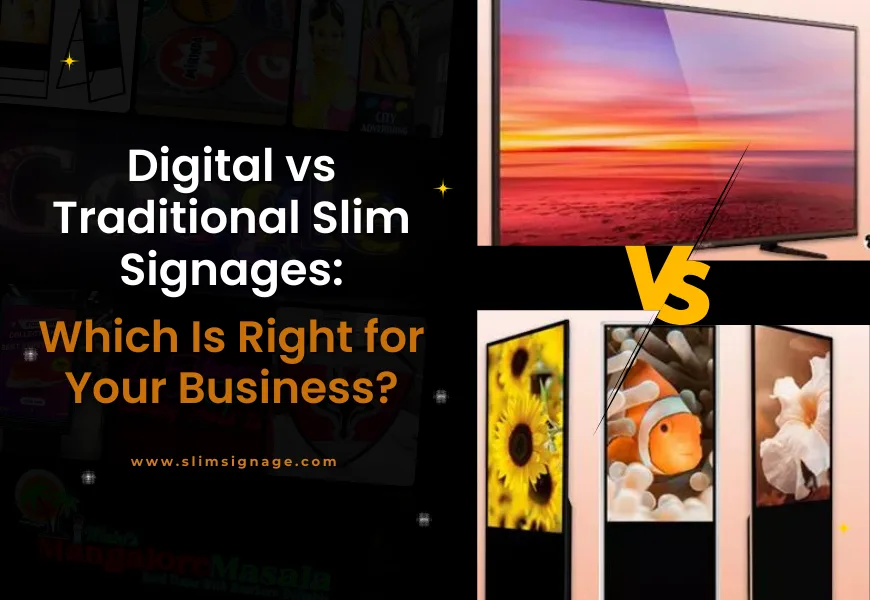Choosing the right type of signage for your business is important. Signage helps you attract customers, share promotions, and build your brand. Today, businesses can choose between digital slim signages and traditional slim signages. Both have their advantages, but which one is best for you? Let’s break it down in simple terms.
What Are Digital Slim Signages?
Digital slim signages use screens like LED or LCD to display content. They are dynamic and can show videos, images, or even live updates. You’ll often see them in places like stores, airports, or restaurants.
Benefits of Digital Slim Signages
- Change Content Easily: You can update your message in real-time, which is great for sharing promotions, offers, or information quickly.
- Eye-catching: The bright screens grab attention, making it hard for people to miss your message.
- Interactive: Some digital signs let customers interact with the screen, giving them a more engaging experience.
- Saves Money Long-term: While they cost more upfront, you don’t need to keep paying for new prints every time you want to change something.
- Environmentally Friendly: No printing means less waste, which is better for the planet.
Drawbacks of Digital Slim Signages
- High Initial Cost: They can be expensive to set up.
- Maintenance: You’ll need to keep the screens and software working properly.
- Energy Use: Digital signs need power to run, which can add to your electricity bill.
What Are Traditional Slim Signages?
Traditional slim signages are non-digital signs made from materials like vinyl or plastic. These include posters, banners, or boards with fixed messages. You see them outside stores or inside businesses.
Benefits of Traditional Slim Signages
- Affordable: They are cheaper to buy and set up than digital signs.
- No Power Needed: Since they aren’t digital, they don’t need electricity and can be placed anywhere.
- Simple and Classic: They provide a timeless look and are easy to design and use.
- Easy to Install: Just hang them up, and they’re ready to go!
Drawbacks of Traditional Slim Signages
- Fixed Content: Once printed, the message can’t be changed. You’ll need to create new signs for updates.
- Recurring Costs: If you change your offers or promotions often, you’ll have to keep buying new signs.
- Less Attention-Grabbing: Traditional signs might not stand out as much, especially in busy areas.
Factors to Consider When Choosing Between Digital and Traditional Slim Signages
To decide which type is right for your business, think about these key points:
1. Budget
- If you want to spend less upfront, **traditional signage** may be the way to go.
- However, if you plan to change your message often, **digital signage** might save you money in the long run.
2. Brand Image
- If your brand is modern or tech-focused, **digital signage** fits that vibe.
- If your business has a classic, timeless appeal, **traditional signage** may suit you better.
3. Flexibility
Need to change promotions or information regularly?
- Digital signage lets you update easily without printing new signs.
- Traditional signs are more permanent and best for businesses with fixed messages.
4. Location
- If you need signs in places where electricity isn’t available, traditional signs are more practical.
- In busy areas, digital signage stands out more and can attract more attention.
5. Maintenance
- Traditional signs don’t need much care, but they might fade or get damaged over time.
- Digital signs need regular maintenance but can last longer and stay looking fresh.
Which Signage Is Best for Your Business?
The right choice depends on your business needs and budget.
- Digital signage is great if you want to update your content frequently and make a bold statement with eye-catching displays.
- Traditional signage works well if you need a simple, affordable option and don’t plan on changing your message often.
In some cases, using both can be a smart move. You can use digital signs for promotions and keep traditional signs for things like your logo or hours of operation.
Conclusion
Both digital and traditional slim signages have their strengths. Consider your budget, how often you need to update your content, and where your signs will be placed. No matter which type you choose, good signage will help boost your business and attract more customers.
Need help deciding? Contact us, and we’ll guide you to the best option for your business!






